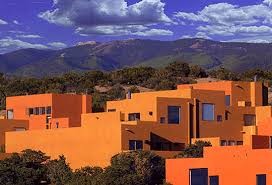
Santa Fe, New Mexico is known as the premier location of the quintessential southwestern style. This style includes traditional southwestern Pueblo, Territorial, and other regional architectural elements. Some of these elements incorporate earth-toned stucco walls, exposed beams (vigas), large covered porches (portales), flat roofs, terra cotta tiles for floors/walls, high-desert minimalist landscaping, and other traditional components. The styles pre-date New Mexico’s statehood in 1912 and they have direct links to the pre-statehood territorial period of 19th and early 20th century. In the late 1950’s the city of Santa Fe passed ordinances controlling the look of new and rebuilt construction, especially in its historic districts, as a continuation of the Santa Fe Style. Other cities, with significant historic districts, have also adopted strict architectural guidelines; notably the American southeast cities of Charleston, SC and Savannah, GA.
+++++++++++++++++++++++++++++++++++++++++++++++++++++++++++++++++++++++++

Bataan Building, Territorial Style (Governmental)– Santa Fe

Zocalo Condos, Pueblo Style (Residential)– Santa Fe

NM State Capitol, Native American Kiva Style (Governmental)-Santa Fe
++++++++++++++++++++++++++++++++++++++++++
Albuquerque, which is New Mexico’s largest city, has less stringent architectural mandates as compared to Santa Fe. The city is a mix of contemporary American styles, some southwestern styles, and some interesting hybrids. Southwestern hybrid styles have surfaced in other American southwest cities, as well; This includes such cities as El Paso TX and Tucson AZ.
+++++++++++++++++++++

Bernalillo County Courthouse – Albuquerque

Sandia Resort – Albuquerque Metro

Rio Rancho City Hall – Albuquerque Metro

UNM Hospital – Albuquerque

UNM Cancer Center – Albuquerque

Marriott Pyramid Hotel – Albuquerque
